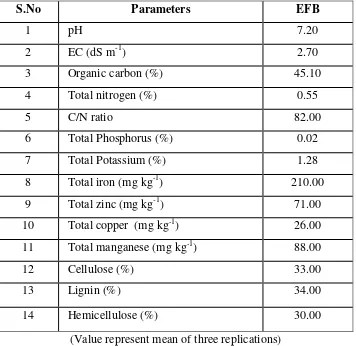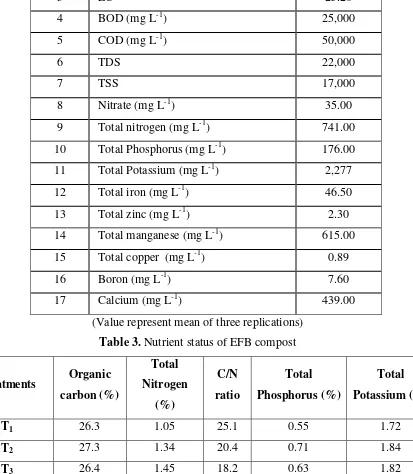EMPTY FRUIT BUNCH- A POTENTIAL ORGANIC MANURE FOR
AGRICULTURE
*Kavitha, B., P. Jothimani and G. Rajannan
Department of Environmental Sciences, Tamil Nadu Agricultural University, Coimbatore-3 E-mail: [email protected] (*Corresponding Author)
Abstracts: The present study was undertaken to utilize the solid wastes generated by palm oil industries in an effective manner for producing manure and value added products. To improve the efficiency of composting, the organisms such as Streptomyces sp., Bacillus sp. and Phanerochaete chrysosporium were used. Among the treatments, the treatments involving the combination of Streptomyces sp., Bacillus sp. and P. chrysosporium exhibited marked differences with respect to C/N ratio and increases in the macro nutrients (N, P and K) and micro nutrients (Zn, Fe, Cu and Mn contents).
Introduction
The oil palm fruit generates two components of products namely crude palm oil (CPO) and crude palm kernel oil (CPKO). CPO is obtained from the mesocarp and CPKO is obtained from the endosperm (kernel). During the extraction process, it generates by-products and wastes known as Empty fruit bunh (EFB), palm oil mill effluent (POME), sterilizer condensate, palm fibre and palm kernel shell (Yusoff, 2006). Annually, 90 million tonnes of renewable biomass in the form of trunks, fronds, shells, palm press fiber, and empty fruit bunch (EFB) are accumulated, where the EFB represents about 9 % (Bari et al., 2010). The EFB is a lignocellulosic material which typically contains 25% lignin, 50% cellulose and 25% hemicellulose in their cell wall. In the past years, EFB was being used as fuel to generate steam in the palm oil industries. The burning of EFB caused serious environmental concern and the authority imposed strict rules to curb air-pollution from such activities. The incineration of EFB in the palm oil mills is restricted by the Department of Environment (DOE) (Astimar and Wahid, 2006).
Nowadays, EFB is used as mulch in agricultural lands to control weeds, maintain moisture and prevent soil erosion (Molla et al., 2004; Alam et al., 2005; Bari et al., 2009; Alam et al., 2009; Misson et al., 2009). However, due to the increased cost of labor and transport its utilization as mulch is becoming more expensive. Therefore, a growing interest has been
generated to develop an environmentally sound and cost-effective alternative to dispose the EFB in a short period of time. Composting is the most suitable option amongst the wastes management strategies with economic and environmental profits since this process reduces the bulk volume of organic materials, eliminates the risk of spreading of pathogens, weed seeds or parasites associated with direct land application of manure and leads to final stabilized products, which can improve and sustain soil fertility. Composting of the empty fruit bunch (EFB) with the palm oil mill effluent (POME) could simultaneously treat the solid and liquid waste from palm oil mill.
The composting of lignocellulosic EFB takes a longer period of time which is considered as the most blocking stump of this eco-friendly disposal technique (Chen et al., 1992; Esse et al., 2001). Lignocellulolytic micro- organisms are the key agents in depolymerizing the lignin barrier in organic materials. Hence, the present investigation was carried out with effective lignocellulolytic microorganisms for accelerating composting of EFB.
Materials and Methods
The Empty fruit bunch collected from Cauvery Palm Oil Limited, Varanavasi, Ariyalur (taluk) was assessed for its physico-chemical and biochemicals characteristics. After the characterization, the Empty fruit bunch (EFB) was composted in heaps of 80 kg. Microbial inoculants such as Bacillus sp., Streptomyces sp. and Phanerochaete chrysosporiym were added to improve the efficiency of composting. The composting was done in the Central Farm Unit at Tamil Nadu Agricultural University, Coimbatore with following treatment combinations.
Treatment details
T1: Empty fruit bunch (EFB) + FYM (Uninoculated control) T2: Empty fruit bunch (EFB) + Streptomyces sp.
T3: Empty fruit bunch (EFB) + Bacillus sp.
T4: Empty fruit bunch (EFB) + Phanerochaete chrysosporium T5: Empty fruit bunch (EFB) + Streptomyces sp. + Bacillus sp.
T6: Empty fruit bunch (EFB) + Streptomyces sp. + Bacillus sp. + Phanerochaete chrysosporium
Results and Discussion
Characteristics of Empty fruit bunch (EFB)
The Empty fruit bunch was neutral in pH (7.20) with EC of 2.70 dS m-1. The EFB recorded the total N, P and K content of 0.55, 0.02 and 1.28 per cent, respectively. The organic carbon content of EFB is 45.10 per cent. The micronutrients viz., Fe, Zn, Cu and Mn were found to be 210.00, 71.00, 26.00 and 88.00 mg kg-1, respectively. The EFB was found to contain 33.00 per cent cellulose, 34.00 per cent lignin and 30.00 per cent hemicellulose (Table 1). These results are in agreement with the findings of Suhaimi and Ong (2001) who reported that the Empty fruit bunch contained 0.52 per cent N, 0.05 per cent P and 1.34 per cent K. According to Deraman (1993), Empty fruit bunch composed of 45-50 per cent cellulose and about equal amount of hemicellulose and lignin. The results clearly indicated that the EFB contain macro and micronutrients with high C/N ratio of 82.00. The woody substrate like cellulose, hemicellulose and lignin indicated that the EFB is hard to degrade.
Characteristics of of Palm oil mill effluent (POME)
The Palm oil mill effluent was acidic in pH (4.70) with EC of 25.20 dS m-1. The BOD, COD, TDS and TSS of the effluent were 25,000, 50,000, 22,000 and 17,000 mg L-1, respectively. The effluent recorded the total N, P and K content of 741.00, 176.00 and 2,277 mg L-1, respectively. The nitrate content of the effluent was 35.00 mg L-1. The micronutrients like Fe, Zn, Mn, Cu, Bo and Ca were 46.50, 2.30, 615.00, 0.89, 7.60 and 439.00 mg L-1, respectively (Table 2). The similar trend was observed by Suhaimi and Ong (2001) who reported that the Palm oil mill effluent contains 750, 180, 2270, 40,000 and 18,000 mg L-1 of N, P, K, respectively. POME is compose of high organic content mainly oil and fatty acids and are able to support bacterial growth to reduce its pollution strength (Mumtaz et al., 2008). Direct discharge of untreated POMEinto aquatic environments may cause some pollution problems;as such its treatment requires efficient and rapid technology(Singh et al., 2010).
Nutrient status of EFB compost
matter with the addition of humic substances. The weight loss due to the release of carbondioxide and mineralization of nitrogen during decomposition of organic matter might have resulted in increased nitrogen content in finished compost. Mahimairaja et al. (1994) also reported increased nitrogen content in finished compost. Bernel et al. (1998) indicated that the nitrogen usually increased during composting process when volatile solid loss is greater than the loss of ammonia. The enhancement in the concentration of these nutrients might be due to mineralisation of organic wastes, accompanied by the reduction in the total volume of the wastes under ideal condition. These findings are in confirmation with the findings of Metting (1993) who reported that during decomposition, microorganisms assimilate complex organic substances and release inorganic nutrients.
Table 1. Physico-chemical properties of Empty fruit bunch of palm oil industry
S.No Parameters EFB
1 pH 7.20
2 EC (dS m-1) 2.70
3 Organic carbon (%) 45.10
4 Total nitrogen (%) 0.55
5 C/N ratio 82.00
6 Total Phosphorus (%) 0.02
7 Total Potassium (%) 1.28
8 Total iron (mg kg-1) 210.00
9 Total zinc (mg kg-1) 71.00
10 Total copper (mg kg-1) 26.00
11 Total manganese (mg kg-1) 88.00
12 Cellulose (%) 33.00
13 Lignin (%) 34.00
14 Hemicellulose (%) 30.00
(Value represent mean of three replications)
Table 2. Physico-chemical properties of Palm oil mill effluent
S.No Parameters POME
1 Colour Yellow
Fig.1. Empty fruit bunch of oil palm
Conclusion
As India is an agricultural base country, there are a lot of agricultural residues left over. As the world palm oil demand is increasing generation of waste is also increasing. If they are discharged untreated, they may cause serious problem and deteriorates the environment in contact. EFB is one of the most available agricultural residues generated from palm oil industry. Thus environmental management through waste management should be given main emphasis. There is a need of appropriate waste minimization or recycling technology which should be easy to operate and cost effective. As palm oil mill effluent is non toxic and considered as a good source of organic nutrients land application of POME can be a suitable waste management option. Use of composting as well as vermicomposting technology is also an efficient waste management option. From this study, it can be concluded that EFB can be used as alternative substrate for production of eco-friendly and sustainable organic manure.
Acknowledgements
The authors would like to thank Cauvery Palm Oil Limited, Varanavasi, Ariyalur for providing empty fruit bunches to carry out this experiment.
References
[2] Alam, M.Z., A.A. Mamun, I.Y. Qudsieh, S.A. Muyibi, H.M. Salleh and N.M. Omar. 2009. Solid state biodegradation of oil palm empty fruit bunches for cellulase enzyme production using a rotary drum bioreactor. Biochem. Eng. J. 46: 61–64.
[3] Astimar, A.A. and M.B. Wahid. 2006. Supply outlook of oil palm biomass in Malaysia. Proceeding of the seminar on ecomat research and promotion. Beijing, China, 24-25 July 2006: Towards Enrichment of the Environment.
[4] Bari, M.N., M.Z. Alam, S.A. Muyibi, P. Jamal, A.A. Mamun. 2010. Effect of particle size on production of citric acid from oil palm empty fruit bunches as new substrate by wild Aspergillus niger. J. Appl. Polym. Sci. 10(21): 2648-2652.
[5] Bari, N.M., M.Z. Alam, S.A. Muyibi, P.Jamal and A.A. Mamun. 2009. Improvement of production of citric acid from oil palm empty fruit bunches: Optimization of media by statistical experimental designs. Biores. Technol., 100: 3113–3120.
[6] Bernal, M. P., C. Paredes, M. A. Sanchez and J. Cegarra. 1998. Maturity and stability parameters of composts prepared with a wide range of organic wastes. Biores. Technol., 63: 91-99.
[7] Chen Y, Y. Inbar and Y Hadar. 1992. Composted residues reduce peat and pesticide use. Biocycle, 33(6): 48–51.
[8] Deraman, M. 1993. Carbon pellets prepared from fibre of oil palm empty fruit bunches: I, A. quantitative X- ray diffraction analysis. PORIM Bull. Palm Oil Res. Inst. Malaysia, 26: 188-192.
[9] Esse, P.C., A. Buerkert, P. Hiernaux and A. Assa. 2001. Decomposition of and nutrient release from ruminant manure on acid sandy soils in the Sahelian zone of Niger, West Africa. Agric. Ecosyst. Environ. 83: 55-63
[10] Mahimairaja, S., N. S. Bolan and M. J. Hedley. 1995. Agronomic effectiveness of poultry manure composts. Commun. Soil plant anal, 26(11 and 12): 1843-1861.
[11] Metting, F. B. 1993. Soil microbial ecology. Application of agricultural and environmental management. (Ed.) Marcel Dekker, New York.p.184.
[12] Misson, M., R. Haron, M.F.A. Kamaroddin and N.A.S. Amin. 2009. Pretreatment of empty palm fruit bunch for production of chemicals viacatalytic pyrolysis. Biores. Technol., 100: 2867–2873.
[14] Mumtaz, T., S. Abd-aziz, N.A. Abdul Rahman, L.Y. Phang, Y. Shirai and M.A. Hassan. 2008. Pilot-scale of recovery of low molecular weight organic acids from anaerobically treated palm oil mill effluent (POME) with energy integrated system. Afr. J. Biotechnol., 21: 3900-3905.
[15] Sardessai, S. 1989. Humic and fulvic acids in sediments of the Hooghly estuary and some
coastal areas in the northern Bay of Bangal. Indian J. Marine Sci., 18: 16-20.
[16] Singh, R., M. Ibrahim, N. Esa, and M. Iliyana. 2010. Composting of waste from palm oil mill: A sustainable waste management practice. Rev. Environ. Sci. Biotechnol. 9(4): 331-344.
[17] Suhaimi, M. and H.K. Ong. 2001. Composting empty fruit bunches of oil palm. Malaysian Agricultural Research and Development Institute. pp. 23-31.

